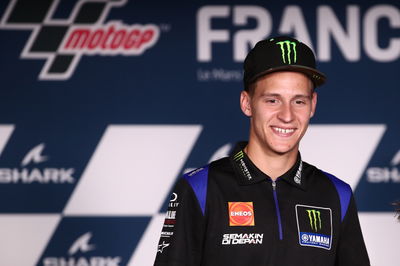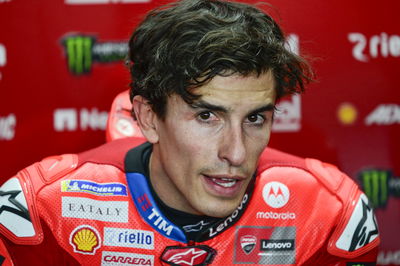UPDATED Bagnaia: If I was illegal, so were 18 riders this season...
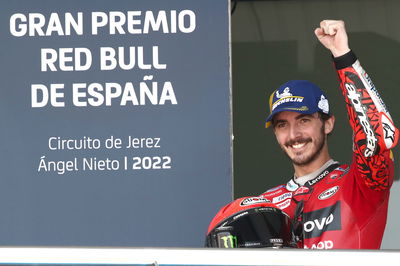
Update: On Thursday evening, the following statement was issued on behalf of MotoGP Technical Director Danny Aldridge, in response to 'recent allegations in the media asserting that some MotoGP teams have breached or have been breaching the regulations regarding tyre operating parameters':
"In cooperation with the MSMA and following a request from the MSMA, the Technical Direction of the Championship is currently in the process of evaluating a new tyre pressure monitoring protocol. This procedure must include the introduction of a unified sensor and receiver system, because it is the only way to have reliable data for scrutineering. In addition, a detailed protocol of how the new regulations will be enforced has been discussed with the MSMA and it has been unanimously agreed that it will not be implemented before the start of the 2023 season.
"This protocol has preliminary been agreed within the MSMA on the condition that it would be evaluated by all manufacturers during the 2022 season. To aid in this evaluation, all manufacturers have unanimously agreed to freely share their riders' tyre data after each event with all other manufacturers; as this data is supplied voluntarily and the sensors are calibrated individually by each sensor manufacturer, it cannot currently be verified for its accuracy.
"As agreed between Michelin, FIM, IRTA, MSMA and Dorna, the tyre regulations will continue to be enforced as they have been for many years, under the control of the Technical Director and Michelin, until such time that the proposed new procedure is ready to be introduced."
Earlier this week, motorsportmagazine.com published a tyre pressure printout, handed privately to the teams after each race, which listed four riders as failing to meet minimum tyre pressures at the Spanish Grand Prix.
The minimum pressure stipulated by Michelin, for safety reasons, is 1.9 bar for the front tyre and 1.7 bar for the rear.
However, because of the fluctuating nature of tyre pressure during a race, the ‘limit’ specified on the printout refers to whether each rider was above the minimum pressure for at least 12 of the 25 race laps.
- Keith Huewen: Suzuki should pay massive penalty for MotoGP ‘Sexit’
- Joan Mir was ready to sign at Suzuki - Honda, Yamaha rumours ‘false’
- Official: Suzuki in discussions ‘to end MotoGP participation’
The printout stated that Bagnaia’s front tyre pressure had been below the minimum for the entire 25 laps, with Pramac Ducati’s Jorge Martin only reaching the minimum pressure for one lap. The amount they were under was not listed.
Others failing to complete at least 12-laps above the specified minimum were RNF Yamaha’s Andrea Dovizioso (whose rear tyre was one lap short, at 11 laps) and Suzuki’s Alex Rins (also 11 laps, but for the front).
Running a lower tyre pressure increases grip and therefore performance by creating a larger contact patch, but the resulting rise in heat can cause safety issues, hence all major motorsport championships have specified minimum pressures (albeit measured in different ways).
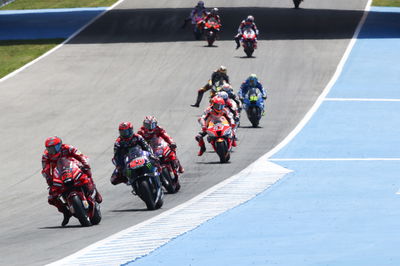
No penalties until 2023
The Jerez printout certainly looked damning, but while tyre pressure data is compiled and shared among the teams for each race with a 'yes-no' verdict given on whether each rider was equal or over the limit, no action is currently taken for those that ‘breach’ the minimum for over half of the race.
Why?
Prior to the controversy being made public, Michelin's Piero Taramasso confirmed that although there is a procedure to monitor and share minimum tyre pressures, penalties are currently not applied.
“Half of the race has to be at the minimum pressure. It's the same rule that they use for Moto2. It's also the one we use also in MotoE,” Taramasso said.
“For the moment there's not a penalty, there's just a warning, like a yellow card and red card.
“We share all the results with all of the teams, so everybody knows who is respecting or not. So it's very open. We work with trust and with confidence with everybody.
“But starting next season, we will still apply the [same] procedure, but we will apply penalties for teams and riders who do not respect that [rule].”
Taramasso added that the main reason for waiting until 2023 is that currently there are several different tyre pressure sensors in use by the MotoGP teams.
“In order to have a reliable measurement, we need everybody with the same sensor,” Taramasso said. “Today we have three different manufacturers, so we need to pick one for this [in future]. So that everyone has the same, because the tolerances are different.”
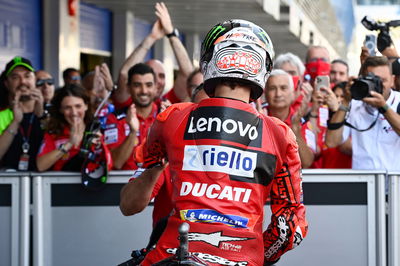
Dall’Igna: Pressure sheet ‘proves nothing’
Responding to the tyre pressure printout, Ducati Corse general manger Gigi Dall’Igna also highlighted the current difference in sensors (and therefore accuracy) used by the various manufacturers, adding that the possibility also currently exists for such sensor data to be ‘faked’ to show false figures.
“In front of a judge it would prove nothing,” Dall’Igna said.
Dall’Igna added that the purpose of the current shared pressure data is to help create the official system of components and procedures from 2023. He also revealed that other, non-Ducati riders have won races this year while failing to meet the current half-race minimum pressure limit.
Why does front tyre pressure change so much?
The difficulty in creating clear tyre rules is due to the significant changes in pressure that occur during a race.
Firstly, there’s the obvious rise in temperature, and therefore pressure, during the opening laps.
“The way the tyre works, you start lower [than the minimum pressure] and after 4-5 laps it goes up to the target [pressure] and then it stays stable until the end,” Taramasso said.
But while the rear pressure should then stay more-or-less stable, things are more complicated for the front tyre.
If a rider has clear air ahead of them, as in the case of Bagnaia (leading) and Martin (re-joining at the back after falling on the opening lap) the front tyre will be at a lower temperature and pressure than if they were closely following another rider.
In other words, it’s not an exact science and there have often been cases where riders have been caught out by soaring front tyre pressures, causing a lack of grip, when battling during a race.
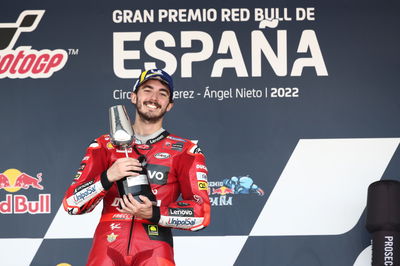
Bagnaia: If I was ‘illegal’, so were 18 others
“You do a pressure thinking also that if you start in front you have the possibility to not get a [higher] pressure, but if you are behind for sure this pressure will go up,” Bagnaia said on Thursday at Le Mans. “So it’s difficult to predict on a track like Jerez that was hot.”
Exactly who might have been below the minimum level at other races is not publicly known, but Bagnaia put the total figure at 18 riders over the six rounds.
“I read that I was in an illegal situation but this means also that 18 riders from the start of the season were illegal. But no-one was penalised. So we are speaking about nothing,” he said.
“If you ask the other riders, I’m quite sure they’ll agree with me because with the rear it’s more easy, with the front it’s more difficult and Michelin just have a suggestion for you. Advice for you, for the tyre pressure. But it’s not mandatory.”
Bagnaia then revealed how much he had been under: “I did the race in Jerez from 1.85 to 1.89 [bar] so it’s doesn’t change a lot.”
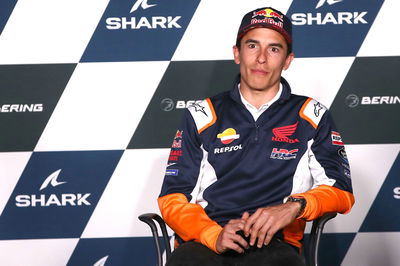
Marc Marquez: Aerodynamics adding to the problem
Eight time world champion Marc Marquez feels the sensitivity of the tyres is partly due to the increasingly influence of aerodynamics.
“I completely agree with Pecco. And lower pressure in the front doesn’t always mean more performance. Sometimes it’s even worse,” he said. “But what I feel is that with the new aerodynamics, the new MotoGP philosophy, is making it more difficult to overtake and ride behind the others.
“It’s more critical for the front tyre pressure because when you are alone you use your aerodynamic things to turn and don’t push a lot the front tyre. But when you are behind somebody, you don’t have the downforce and then you push more the steering, push more the tyre and then the temperature is going up. So it becomes more and more critical every year.
“This is something also that for the future we need to adjust. It’s not just the tyre pressure, the tyre pressure is related to many things.”
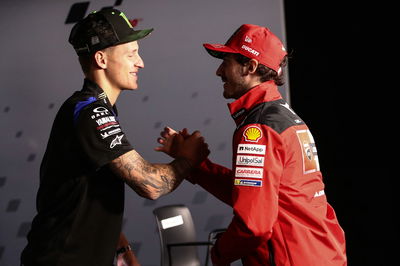
Quartararo: I was lower in Portimao
Reigning world champion and 2022 title leader Fabio Quartararo, who spent the Jerez race in Bagnaia slipstream, indicated that he had been under the minimum pressure after escaping out front in Portimao.
“It happened the same to me in Portimao, I think I was also lower all the race,” Quartararo revealed.
“My plan in Jerez was try to overtake Pecco [at the start] and be alone. But even if you know that you [might] go in front, you prepare for being behind and try to get the lowest [pressure] possible. Because when you are behind, the tyre is going up a lot.”
The Frenchman, who was stripped of a Moto2 win in 2018 due to low tyre pressure, added:
“I think it will be difficult if they make a regulation because if you start too high your race can be super bad or super good. On the rear it’s much easier to control but on the front I think it’s tough,” he said.
The Monster Yamaha rider suggested changes to tyre construction might be one solution: “I think we need to try to make something with Michelin that doesn’t change [behaviour] so much, when you are behind or alone.”
“It’s a very difficult thing for the teams and also for Michelin because as Pecco and Fabio said, how do you know if you are going to be following 3 bikes or will have a free track?” said Aprilia’s Aleix Espargaro.
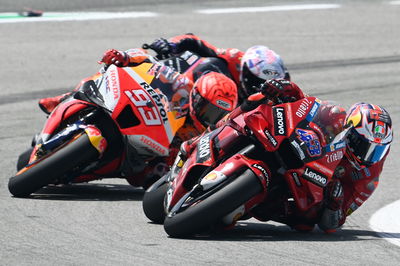
Miller: Tyre pressure on a knife edge
Bagnaia’s comments that he would have been over the minimum had he not been leading were backed up by team-mate Jack Miller, who spent the race battling in a group and was over the minimum pressure at both the front and rear.
“The tyre pressure can be that much on a knife-edge that if you go and lead the whole race, you’re not going to get to the target point. But if you get behind somebody for just one lap, you're on the target point and it will stay there,” said the Australian.
“If you go out and you lead a race the whole way through you don't get any hot air on the front tyre, and they've obviously prepared the bike for that. If he had dropped back behind [someone], pressure would have gone up.”
“One lap behind somebody would instantly put you in the right range,” he added.
Moto2 already takes a stricter approach to minimum pressures, but Miller believes the circumstances are different in MotoGP.
“I feel like the rule was necessary in Moto2 because they're meant to be running 1.5, 1.4 bar and people were running 0.6, 0.8 bar and destroying tyres in a class that's controlled. So you're trying to get any sort of advantage you can over your opponents,” he said.
“With us, we're just trying to ride in the correct range and the how your race plays out determines whether or not you get in that range… 0.1-0.2 bar of pressure difference can be night or day.”
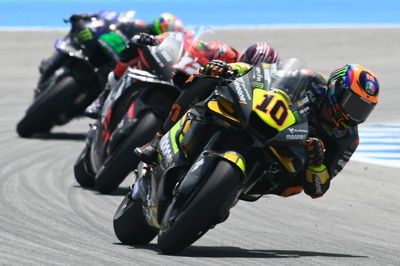
Marini: It's difficult to make great battles like this
Fellow GP22 rider, Luca Marini, who like Miller passes the limit for both the front and rear, explained how sensitive the tyres are to changes in pressure.
“When the temperature is hot it’s a little bit more critical, and when you stay in the slipstream. It changes also if it is behind just one rider or if there are more bikes in front of you. If two or three it is even worse.
“You just try to slow down a bit, create a gap from the rider in front of you, like one second. Then the pressure starts to drop a bit. You can feel better and you can try to push another time and overtake the rider in front as soon as possible because in one or two laps it's impossible [again].
“For the show it will also be better also for the show if we can find a solution, because like you saw in some races, riders need to slow down a bit and create a gap. It's difficult to make great battles like this, because if you stay many laps behind another rider, then it's impossible to ride the bike. It's very, very difficult.
“The problem goes up in steps. First it starts doing more front locking in braking, so it's difficult to stop the bike. Then if the pressure goes very high you start to close also the front in the middle of the corner, in the fast corners especially.”
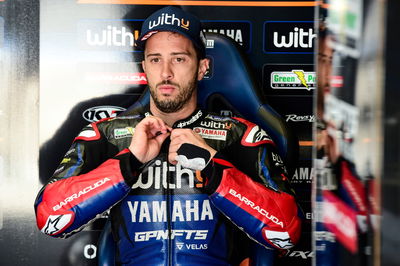
Dovizioso: There are no rules, you can do what you want
Andrea Dovizioso, the oldest and most experienced rider on the grid, admitted it’s a strange situation to have minimum tyre pressures that are not being enforced by penalties.
“There are rules but there are no penalties, so you can do almost what you want,” he said. “I think we need some rules on that. I know they are working to try to manage this.
“I think in my opinion there was some chance to have some rules already this year, but something happened, I don't know what, and it didn't happen. And this is the situation.
“When we start from the first race and the rules say there is no penalty, it's finished. There is no reason to speak about that [illegal tyre pressure or not]. I mean, the rules say you can't race more than 50% under that pressure, but if you do, it's the same.
“So there are no rules. And this is not good, because for Michelin it's very important not to go under a lot.… In this moment you can do what you want, and it depends more about how much the manufacturer wants to risk and stay low.
“If you are lower, it doesn't mean you are better. But it's better to be lower than higher.
“But in any case, it's not good to not have a rule, and I wasn't happy when during the winter, I realised that for this year, there wasn't a penalty for that. But this is the situation and it's the same for everybody.
“If you see the data for every race, you can see a lot of riders were out of the rules. But I don't want to say they are out of the rules, because there aren't any rules. So it's OK, it's fair, because this is the situation.”
